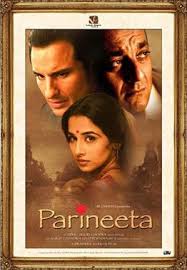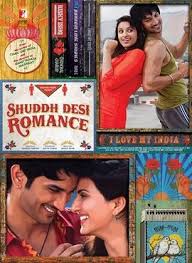Love, pride, and tradition intertwine in a deeply evocative narrative set in 1960s Calcutta. Parineeta stars Vidya, Saif, and Sanjay, drawing viewers into a world of aristocratic grandeur and emotional complexity. Based on Sarat Chandra Chattopadhyay’s classic novel, the film fits into the romantic drama genre, capturing the elegance and tension of an era where social status and personal relationships were intricately bound. The movie’s nostalgic setting is painted with a brush of old-world charm, as it delves into love stories overshadowed by pride and societal expectations.
The plot revolves around childhood friends, Shekhar and Lolita, who share an unspoken bond of love. Their lives are tied together by more than just friendship; they’re family in spirit, with Lolita being taken in by Shekhar’s family after her parents’ demise. As they grow older, Shekhar, played by Saif, becomes a successful musician, while Vidya’s Lolita nurtures a quiet, enduring love for him. However, when a wealthy outsider, Girish, enters Lolita’s life and offers to help her financially struggling family, misunderstandings, pride, and jealousy take center stage. Shekhar’s ego, fueled by insecurities and misunderstandings, threatens to shatter the delicate love between him and Lolita. The movie navigates through their journey of love, heartbreak, and eventual realization, while the looming threat of class divide remains ever-present, creating a rich backdrop of emotional depth.
One of the strongest aspects of the film is Vidya’s performance. In her debut role as Lolita, she exudes a subtle grace that captures the very essence of her character’s inner strength and vulnerability. Her portrayal is understated but powerful, as she balances the weight of tradition, familial responsibility, and personal love. Vidya’s chemistry with Saif’s Shekhar is palpable, and the contrast between her quiet resilience and his tempestuous pride plays out beautifully on screen. Saif brings complexity to Shekhar’s character, portraying him as a man torn between love and ego. His transformation from a playful, confident man to someone consumed by jealousy and insecurities is delivered with nuance. Sanjay, in the role of Girish, provides a calming balance to the emotional turmoil between Lolita and Shekhar. His restrained performance adds depth to a character who could have easily been portrayed as a one-dimensional rival.
The direction by Pradeep is masterful in its attention to detail, both in terms of setting and character development. Every frame is steeped in the cultural and social intricacies of 1960s Calcutta, and the film’s pacing ensures that the emotional beats are given the time they need to resonate. The opulence of Shekhar’s family mansion is juxtaposed against the simplicity of Lolita’s home, emphasizing the stark differences in their social standing. The attention to period-specific costumes and settings adds to the authenticity of the film’s world, with Lolita’s simple saris contrasting beautifully with the grand interiors of Shekhar’s home. The costume design reflects the characters’ personalities, with Shekhar’s stylish suits reflecting his modern, affluent lifestyle, while Lolita’s traditional attire underscores her simplicity and grace.
The film’s cinematography is another standout element, with artful shots that enhance the storytelling. Cinematographer Nataraja ensures that each frame is a visual treat, capturing the beauty of Calcutta with a nostalgic lens. Whether it’s the sweeping shots of the city’s colonial architecture or the intimate close-ups of the characters, the camera work adds layers to the narrative. The lighting, in particular, creates a soft, almost dreamlike quality that enhances the romantic tension in the story. The use of shadows, especially in moments of Shekhar’s inner turmoil, adds to the depth of his character’s emotional journey.
Music plays a significant role in the film, with Shantanu’s soundtrack beautifully complementing the emotional tone. The songs, like “Piyu Bole” and “Kaisi Paheli Zindagani,” are not just interludes but integral parts of the storytelling. The lyrics are poetic and rich in meaning, enhancing the emotional weight of the scenes they accompany. The use of traditional instruments and classical compositions grounds the film in its period setting while also adding to its timeless quality. The background score is subtle yet effective, swelling at just the right moments to heighten the emotional intensity of key scenes without overpowering them.
The film also explores themes of class and social standing, which are woven intricately into the personal dynamics of the characters. Shekhar’s pride is not only a product of his personal insecurities but also a reflection of the rigid class structures of the time. Lolita, despite her deep love for Shekhar, remains acutely aware of the power dynamics at play, and this awareness informs much of her character’s restraint throughout the film. The film handles these themes with sensitivity, using the characters’ personal journeys as a microcosm for the broader societal tensions of the time.
In terms of editing, the film flows seamlessly from one emotional high to the next, never lingering too long on any particular subplot. The narrative is tight, and while the film is rich in its emotional scope, it never feels overburdened by its own weight. The balance between moments of lightheartedness, tension, and drama is maintained throughout, ensuring that the audience remains engaged from beginning to end.
Overall, Parineeta is a beautifully crafted film that succeeds on many levels. Its strength lies not just in the compelling performances but also in its attention to period detail, its evocative music, and its thematic depth. The film captures the essence of the original novel while also making it accessible and relevant to modern audiences. It’s a movie that resonates emotionally, with its exploration of love, pride, and societal expectations leaving a lasting impact. Highly recommended for those who appreciate classic romance intertwined with social commentary, Parineeta is a cinematic gem that shouldn’t be missed.







